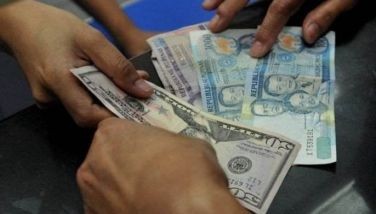Maybe B-O-T is no cure all

Government, through the DBP and the Land Bank, has bought control of the EDSA MRT. The GFIs are increasing their combined shareholdings in MRTC to 76 percent by the end of the month from 56 percent now, and that would increase the government’s board seats in the company to ten from six.
Both banks started acquiring shares in MRTC in December, when they bought 26 percent, and eventually increased that to 56 percent in February. What looks like a reverse privatization move will actually benefit the riding public. The MRT had long been aching for additional investments to increase capacity and improve maintenance but the funds are not forthcoming from the private investors.
The problem with the MRT is that government guaranteed the investors a 15 percent return. Because government does not have the nerve to increase fares, it ends up paying a hefty sum in subsidy to the investors. Government’s usual cash problems have prevented it from making up to date payments and the delinquency has led to arbitration cases being filed by the MRT Consortium in Singapore and in Washington. Maybe, this buy out by the GFIs solves those cases.
They should have thought of doing this some years back. The Filipino taxpayer has spent a bundle on MRT subsidies to guarantee the profits of the private sector investors. The service to commuters could have also been upgraded sooner. In a sense, the MRT seems to indicate that there are some services that should remain with government. Mass transit systems all over the world are usually government.
Besides, the MRT B-O-T proposal had been plagued with problems and questions from the start. It would seem that the only one who really made money on the deal with no money risked was a glib-talking early proponent with a well connected network in government and local big time investors. And he was out of it by the time they were breaking ground.
It also seemed that government was being cooked in its own fat, so to speak with the sovereign guarantee of the consortium’s loan and the subsidy to guarantee the 15 percent return to the investors. Government is also running the system which leaves the question, what did the private sector really contribute to the deal?
This is why I don’t think Finance Secretary Gary Teves should sound too apologetic for this seeming reverse privatization. “This will only be temporary because eventually we’ll dispose of the shares,” Teves said, “we don’t want to be involved in the business, and we will go back to privatizing it again.”
Gary should take his time privatizing it again. Before he does that, he must make sure there is a benefit to the taxpayers and the commuters. He must sit back and learn the lessons from this unfortunate B-O-T experience that led him to eventually do the right thing: undertake a government buyout of the MRT consortium’s build-lease-transfer contract for the rail transit system.
I understand that when government finally decided to bite the bullet, it was estimated that government would be paying $865 million for the remainder of the contract while realizing savings of up to $380 million. It is a case of a B-O-T gone wrong. The B-O-T deal for the MRT was conceived as a good way of financing a key infrastructure project with little or no funds from the government. That didn’t happen.
MRTC, the private company awarded the B-O-T contract, is majority owned by a holding company, MRT Holdings Inc., a consortium that originally consisted of Ayala Land Inc., Anglo Philippines Holding Corp., Fil-Estate Management Inc., Ramcar Inc., and Greenfield Development Corp. Some of the original shareholders divested from the holding firm and sold their shares to fund managers. It was simply a money deal for them with no commitment for the service MRT was supposed to provide. After the consortium members milked the project of such benefits as the MRT stops at their malls, their interest in the service vanished and the commuters suffered.
Now the government can start investing in an upgrade of the 16.9-kilometer system running from North Triangle in Quezon City to Taft Avenue in Pasay City. They can buy more coaches to reduce the waiting time and accommodate more commuters during rush hours. At its peak during the Christmas holidays, MRT 3 was reportedly ferrying 27,000 passengers per hour in one direction. The government would also save at least P5.7 billion in annual subsidies to keep fares low while paying the guaranteed 15-percent return on investment to shareholders.
Before more mass transit system BOT proposals are approved, government should let the public know the lessons from the MRT 3 experience so that the taxpayers will at least benefit from the high tuition fee that was paid on their behalf. B-O-T isn’t for everything, it seems.
Agriculture
Agriculture Secretary Art Yap sent me a long text message reacting to the comments of a reader to a previous column on rice production/supply.
More than agriculturists, we need an agribusiness perspective today... it is not just productivity and the farming but supply chains and market access. Assuring a market at stable prices for agricultural commodities is key today to sustaining production for the rural incomes they assure our food producers.
We will break the rice production level of 2008 first semester. Planting intentions hit more than 100 percent and irrigated lands and areas for harvested palay increased in the first quarter as against last year. This is proof that irrigated repair work is allowing more farms to be planted on in the dry season.
Our farmers are increasing productivity and remain more so than Thai farmers on a per hectare basis. Statistics of the Bureau of Agricultural Statistics (BAS) show palay prices are also up. They are P16 to P17 per kilo...
Join me around the country to hear how farmers are thankful that prices continue to stay up. But of course to a seller, a price is never that good so farmers continue to ask for higher prices. NFA is trying to oblige them by buying more palay. In 2008, we bought 700,000 metric tons, up from 33,000 metric tons in 2007. We also paid them incentives of P1,800 for tranches of 50 bags of palay sold to the NFA. Procurement price shot up to close to P18 per kilo for clean and dry. BAS statistics and retail prices of rice are evidence of this.
I am not only full of good intentions, we are actually rolling out funds for organic fertilizer sites. And according to Gov. Joey Salceda, loans to the agricultural sector grew by 24 percent in 2008 which he credits the agri guarantee fund pool set up with Landbank. I am doing my best Boo, but we do need everybody’s support.
Anti-women bishops
I got this e-mail from Victor N. Arches II.
The Catholic bishops are at it, again.
Pending in the Philippine Congress for more than 10 years, the Magna Carta of Women was finally consolidated last March 3rd by the bicameral conference committee. The Lower House expects to ratify the measure on April 13 when it resumes its sessions.
What caused the unusual delay were the insertions to the bill, stubbornly proposed by the Catholic Bishops Conference of the Philippines (CBCP). The bishops were insisting on inserting a provision to expel or deny admission to “pregnant but unwed students and teachers” from public, private, and Catholic-run schools and universities. The CBCP proposal was made through Aquilino Pimentel, Raul del Mar and Eduardo Zialcita, all known allies of the bishops.
Not only is the bishops’ position anti-women, it is also anti-life — since such a provision would push “pregnant but unwed” mothers to have abortions, in order to be admitted to schools for an education and/or a livelihood. The bishops’ proposal, in effect, DISCRIMINATES on unwed women in society who decide to continue their pregnancies.
Is it the bishops’ intention to (a) deprive unwed mothers of an education, a livelihood to support their illegitimate children, or (b) condemn the unborn fetus? Is this being “Christian”?
These bishops are WORSE than the Pharisees!
Truly IRRELEVANT.
No wonder no one listens to them anymore.
Prescription drugs
A broadcast reporter was interviewing a notorious public figure what medicines he takes when he feels under the weather.
“Oh,” the usual suspect said, “I take Kwartal, PERAmycin Forte and CUCORAKUtyn-E plus.”
Boo Chanco’s e-mail address is [email protected]
- Latest
- Trending






























